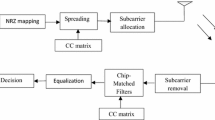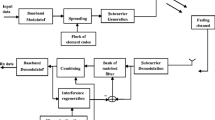Abstract
Complementary coded code-division multiple access (CC-CDMA) has been originated as one of the extremely robust multiuser access technique in designing high data rate systems with frequency diversity for futuristic wireless communication. The integration of multiple-input multiple-output (MIMO) systems with CC-CDMA offers space diversity gain in addition to the achievable frequency diversity in CC-CDMA systems. However, the performance of conventional chip level space–time receiver in MIMO CC-CDMA is deteriorated due to multiple access interference (MAI) and spatial interference under frequency selective fading channels. A zero-forcing receiver used for minimizing MAI provides unsatisfactory performance in interference limited environments due to amplification of noise and hence the use of regularized zero-forcing (RZF) receiver is proposed and investigated in this study to achieve a space–time interference cancellation (STIC) system. Simulation results are performed to reveal the significance of RZF-STIC in achieving performance gain than conventional equalization schemes, and at the same time enhancing frequency diversity and spatial diversity gain with less complexity at all system loads.







Similar content being viewed by others
References
Yee, N., Linnartz, J. P., & Fettweis, G. (1993). Multicarrier CDMA in indoor wireless networks. Proceedings of the IEEE PIMRC, 9, 109–113.
Hara, S., & Prasad, R. (1999). Overview of multicarrier CDMA. IEEE Communication Magazine, 35, 126–133.
Chen, H. H., Chu, S. W., & Guzani, M. (2008). On the next generation CDMA technologies: The REAL approach for perfect orthogonal code generation. IEEE Transactions on Vehicular Technology, 57, 2822–2833.
Chen, H. H., Hank, D., Maganaz, M., & Guizani, M. (2007). Design of next generation CDMA using orthogonal complementary codes and ofset stacked spreading. IEEE Wireless Communicaitons, 14, 61–69.
Magaa, M. E., Rajatasereekul, T., Hank, D., & Chen, H. H. (2007). Design of MC-CDMA systems that uses complete complementary orthogonal spreading codes. IEEE Transactions on Vehicular Technology, 56, 2976–2989.
Li, J., Huang, A., Hank, D., Guizani, M., & Chen, H. H. (2008). Intergroup Complementary codes for interference-resistant CDMA wireless Communications. IEEE Transactions on Wireless Comunications, 7, 166–174.
Judson, D., & Albert Raj, A. (2016). Performance of multicarrier complementary-coded CDMA under frequency-selective Nakagami-m fading channels. EURASIP Journal on Wireless Communications and Networking, 67, 1–9.
Liu, X., Syu, H. M., Chen, H. H., Meng, W., & Wei, M. (2018). Complementary coded scrambling multiple access and its performance in downlink MIMO channels. IEEE Transactions on Wireless Communications, 17, 835–847.
Vucctic, B., & Yuan, J. (2003). Space-time coding (1st ed.). Hoboken, NJ: Wiley.
Alamouti, S. (1998). A simple transmit diversity technique for wireless communication. IEEE Journal Selected Areas on Communications, 16, 141–1458.
Hochwald, B., Marzetta, T., & Papadias, C. (2001). A transmitter diversity scheme for wideband CDMA system based on space-time spreading. IEEE Journal Selected Areas on Communications, 19, 48–60.
Petre, F., Leus, G., Deneire, L., Engels, M., Moonen, M., & Man, H. D. (2003). Space time block coding for single-carrier block transmission DS-CDMA downlink. IEEE Journal Selected Areas on Communications, 21, 350–361.
Shi, M., D’Amours, C., & Yongacoglu, A. (2010). Design of spreading permutations for MIMO-CDMA based on space-time block codes. IEEE Communication Letters, 14, 36–38.
Phasouliotis, A., & So, D. (2011). Layered space-time receiver for downlink multiple input multiple output multi-cattier code division multiple access systems. IET Communications, 21, 1907–1917.
Chen, H. H., Yeh, Y. C., Bi, Q., & Jamalipor, A. (2007). On the MIMO based open wireless architecture: Space time complementary coding. IEEE Communication Magazine, 45, 104–112.
Chen, H. H., Yeh, M., Guizani, Y., & Huang, Y. M. (2008). Space-time complementary coding MIMO with joint spatial diversity and multiplex capability. IEEE Transactions Wireless Communications, 7, 2950–2956.
Judson, D., & Bhaskar, V. (2018). Interference cancellation in CDMA systems employing complementary codes under Rician fading channels. Wireless personal Communication, 101, 897–914.
Meng, W. H., Sun, S. Y., & Chen, H. H. (2013). Multiuser interference cancellation in complementary coded CDMA with diversity gain. IEEE Wireless Communication Letters, 2, 303–306.
Davix, X. A., & Judson, D. (2019). Successive interference cancellation in asynchronous CC-CDMA systems under Rician fading channels. Telecommunication Systems. https://doi.org/10.1007/s11235-019-00562-y.
Judson, D., & Bhaskar, V. (2018). Error rate analysis of SIMO-CDMA with complementary codes under multipath fading channels. Wireless Personal Communication, 98, 1663–1677.
Han, S., Venkatesan, R., Chen, H. H., Meng, W., Li, C., & Yang, P. Y. (2014). A complete complementary coded MIMO system and its performance in multipath channels. IEEE Wireless Communications Letters, 3, 181–184.
Al-Fuhaidi, B. A., Hassan, H. E. A., & Salah, M. M. (2014). Interference cancellation with space diversity for downlink MC-CDMA system. Wireless Personal Communication, 74, 439–456.
Author information
Authors and Affiliations
Corresponding author
Additional information
Publisher's Note
Springer Nature remains neutral with regard to jurisdictional claims in published maps and institutional affiliations.
Rights and permissions
About this article
Cite this article
Judson, D., Bhaskar, V. & Arun, S. Space Time Regularized Zero Forcing in Downlink Code Division Multiple Access Systems with Complementary Codes. Wireless Pers Commun 109, 333–347 (2019). https://doi.org/10.1007/s11277-019-06567-9
Published:
Issue Date:
DOI: https://doi.org/10.1007/s11277-019-06567-9




